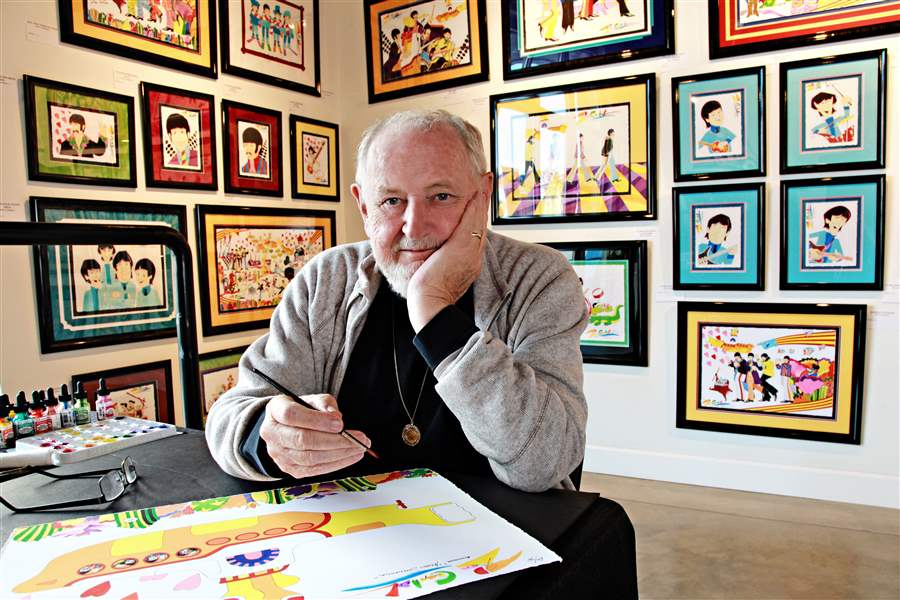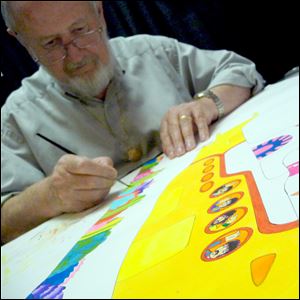
'Scooby-Doo,' 'The Beatles' artist Ron Campbell to speak at River House Arts
10/13/2017
Artist Ron Campbell will be at River House Arts on Tuesday and Wednesday where he will paint new Beatles pop art, showcase other works, and talk cartoons.
NICK FOLLGER
The Beatles didn’t just change music in the 1960s. They changed the world.
In a very small way, Ron Campbell was part of that popular culture phenomenon — he just didn’t know it at the time.
Campbell was a director for the Fab Four's Saturday morning cartoon series, The Beatles, which ran from 1965-69, and he partnered on about 12 minutes of animation in The Yellow Submarine, a 1968 full-length animated classic that represents the ultimate expression if not denouement of the psychedelic art movement of the '60s

Artist Ron Campbell will be at River House Arts on Tuesday and Wednesday where he will paint new Beatles pop art, showcase other works, and talk cartoons.
His sequences included the Sea of Time, and much of the interaction between the Chief Blue Meanie and his sycophant sidekick Max, as well as Jeremy Hillary Boob PhD aka “Nowhere Man.”
Yet the notion that he was even a “small part” of the massive Beatles invasion is something that, even decades later, the 77-year-old never really considered.
“I guess I was,” he said in a recent interview with The Blade to promote his upcoming appearance in Toledo. “To me, I was just doing something that I wanted to do as a small child. But I was a small part of it ... yeah, I guess I was.”
His Beatles work was just the beginning of Campbell’s connection with cultural touchstones. Most of us never knew Campbell, but we invited him into our living rooms every Saturday morning when we watched Scooby-Doo, The Flintstones, The Jetsons, and The Smurfs on console TVs the size of love seats.
Campbell was an animator on those popular cartoons and many others by Hanna-Barbera as well as more recent animated hits like Rugrats on Nickelodeon in the ’90s and Ed, Edd n Eddy on Cartoon Network in the ’00s.
Now retired from the profession, Campbell spends much of his time revisiting his past through paintings he creates and sells in occasional appearances nationwide. Campbell will be in Toledo on Tuesday and Wednesday at River House Arts, in the adjacent Secor Ballroom, 425 Jefferson Ave., where he will paint new Beatles pop art, showcase other works, and talk cartoons from 3 to 8 p.m. both days.
There is no admission fee to the exhibit, and all of his art is for sale. For more information, call 419-441-4025.
“As a painter in the second act of my life, I do paintings based on the TV cartoon shows I worked on and Yellow Submarine,” he said. “When you’re a painter you like to show your paintings, and when you show your paintings you like to sell your paintings.
“I do a show once a month in America," he added. "It's an art show, only the artwork — all of it — is for sale."
Born in 1939 in Seymore, a small town in the Australian state of Victoria, Campbell began his animation career in the late ’50s in Australia, working on Beetle Bailey, Krazy Kat, and Cool McCool — TV show's produced by Al Brodax, who later recruited him to work on The Beatles cartoon.
It was a job pitch that Brodax made with a middle-of-night phone call that woke Campbell from a sound sleep. Brodax told Campbell he had just sold a TV show for the next year and then asked if he would want to direct it?
Campbell jumped at the opportunity. “Of course I would, Al. What’s the show?”
“The Beatles,” Brodax said.
“I'm not sure about a show about insects," Campbell replied.
After Brodax explained the show was about the Beatles and not beetles, Campbell was more receptive to a cartoon about a band and not a bug.
“I’ve heard of them,” he said. “Teenagers go crazy for them.”
Yellow Submarine was another Brodax pitch — but first to the Beatles, who were contractually obligated to appear in three films with United Artists.
Campbell said Brodax suggested to the Fab Four making an animated movie that required no collaboration work on their end. “ ‘We’ll make a feature film and you can go off and do your own thing,’ ” Campbell said Brodax told them. “They had no idea what it looked like, they thought it was just like their TV cartoon show, which they were ambivalent about.”
While the Beatles were hands-off on Yellow Submarine as they had been with their cartoon series — even their voices were provided by soundalike (and not soundalike) actors — the band members’ single contribution to the animated projects was extraordinarily important to the success and legacy of the film and cartoon.
“They gave us their music to use and that’s everything,” Campbell said. “We almost couldn’t miss because of the music. It was all they did — they didn’t do the voices and had no say in the storylines — but it was everything."

Ron Campbell painting Beatles key art.
After Yellow Submarine, Campbell started his own animation studio, Ron Campbell Films Inc., which, rather fortuitously, just happened to be across the street from Hanna-Barbera studios.
“Bill Hanna used to send stuff across the road to me” to animate as a subcontractor. “I found myself working on a tremendous number of Hanna-Barbera projects.”
That’s how Campbell got involved with Scooby-Doo, The Smurfs, and much more. But his connection to childhood nostalgia doesn’t end there.
If you grew up in the ’70s, perhaps you remember The Big Blue Marble, the Saturday morning series that introduced children and cultures from other parts of the world to kids in America.
Campbell helped create and produced all of the animation for the documentary-style Peabody-winning show.
“It was encouraging an understanding between cultures and enabling children to have empathy for other cultures,” he said of the series. It also fostered correspondence between them through its pen pal program. “Many people grew up and remained pen pals with the people.”
By the ’90s, Campbell was directing Disney TV cartoons (Goof Troop, Darkwing Duck, and Winnie the Pooh) and storyboarding Rugrats and Duckman. His final professional project was directing episodes of Ed, Edd n Eddy, perhaps the last animated TV series to use cel animation — at least as far as Campbell knows.
"I was the director of the very last scene of the very last film of Ed, Edd n Eddy," he said. "I retired at the very point where computer-generated films were all there was."
Contact Kirk Baird at kbaird@theblade.com or 419-724-6734.